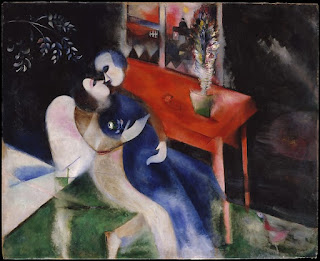I recalled my own amazement, the first time I met her with Saint-Loup, at the thought that anybody could be tormented by not knowing what such a woman had been doing one evening, what she might have whispered to someone, why she had desired a rupture. And I felt that all this past existence - but, in this case, Albertine's - towards which every fibre of my heart, of my life, was directed with a throbbing and importune pain, must appear just as insignificant to Saint-Loup, and would one day, perhaps, appear so to me; I felt that I might gradually pass, so far as the insignificance of gravity of Albertine's past was concerned, from the state of mind in which I was at the moment to that of Saint-Loup, for I was under no illusion as to what Saint-Loup might be thinking, as to what anyone else than the lover himself may think. And I was not unduly distressed. Let us leave pretty women to men with no imagination. I recalled that tragic explanation of so many lives which is furnished by an inspired but not lifelike portrait such as Elstir's portrait of Odette, which is a portrait not so much of a mistress as of the distortions of love. All that it lacked was - what so many portraits have - the fact of coming at once from a great painter and from a lover (and even then it was that Elstir had been Odette's). The whole life of a lover, of a lover whose folly nobody understands - the whole life of a Swann - goes to prove this disparity. But let the lover be embodied in a painter like Elstir and then we have the clue to the enigma,we have at last before our eyes those lips which the common herd have never perceived, that nose which nobody has ever seen, that unsuspected carriage. The portrait says: "What I have loved, what has made me suffer, what I have never ceased to behold, is this." By an inverse gymnastic, I who had made a mental effort to add to Rachel all that Saint-Loup had added to her of himself, I now attempted to subtract the contribution of my heart and mind from composition of Albertine, and to picture her to myself as she must appear to Saint-Loup, as Rachel had appeared to me. But how much importance does all this have? Would we give credence to these differences, even if we could see them ourselves?
Marcel Proust, The Fugitive, pp. 447-448
Marcel continues to talk to his good friend Robert Saint-Loup about his breakup with Albertine, or, more accurately, Albertine's breakup with him. Marcel comes to understand that Robert is just as incapable of "seeing" Albertine as he sees her as he was incapable of seeing Robert's mistress Rachel (or, as Proust always referred to her, "Rachel when from the Lord"). He compares it to the portrait that Elstir had painted of Odette, Swann's long-time mistress and then wife, and who Elstir was rumored to have slept with as well. Proust writes, "The portrait says: 'What I have loved, what has made me suffer, what I have never ceased to behold, is this.'" We may not be artists, but we still always metaphorically paint a portrait of our lovers, but we also have to know that, just as with an artist, the "common herd" will not see what we see. Why is this observation so incredibly important to Marcel at that moment? He no longer possesses Albertine, which means he runs the risk of becoming that mass of men who will not understand or appreciate her beauty, unless he paints that internal portrait of her. But why would he do so? Would that no simply bring him more intense and sustained pain? Doesn't he have to deconstruct his portrait of her; to learn to once again see her as other men see her. "By an inverse gymnastic, I who had made a mental effort to add to Rachel all that Saint-Loup had added to her of himself, I now attempted to subtract the contribution of my heart and mind from composition of Albertine, and to picture her to myself as she must appear to Saint-Loup, as Rachel had appeared to me."


No comments:
Post a Comment